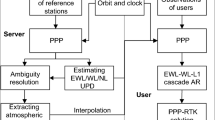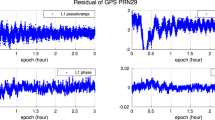Abstract
In order to fully exploit the advantages of both precise point positioning (PPP) and real-time kinematic (RTK), a PPP–RTK method has been proposed to achieve centimeter-level positioning by applying the rapid integer ambiguity resolution, which is now widely implemented in some commercial systems such as Trimble RTX-Fast and NavCom StarFire. Nevertheless, the performance of PPP–RTK faces with restrictions under the circumstance of urban environments due to intermittent signal interruptions and unfavorable tracking geometry. Presently, it is increasingly prevalent that the inertial navigation system (INS) is integrated with global navigation satellite system (GNSS) to serve for enhancing the positioning performance. In this contribution, a tightly coupled PPP–RTK/INS integration model is developed, aiming to provide continuous and precise positioning service under the complex urban environments. In the proposed model, the precise atmospheric corrections derived from the multi-GNSS PPP fixed solutions of reference stations are disseminated to users to enable the rapid ambiguity resolution in PPP–RTK/INS. Furthermore, the high-accuracy position information offered by INS is also used to enhance the performance of ambiguity fixing. Experiments in different scenarios of urban roads and overpasses were designed to verify the effectiveness of the proposed method. Results indicate that the solution availability, fixing percentage and positioning accuracy can be significantly improved by PPP–RTK/INS integration. The horizontal positioning accuracy of the tightly coupled PPP–RTK/INS is 1–2 cm in a semi-urban environment and 5–6 cm in a real urban environment with a fixing percentage of 90.7% and 81.2%, respectively. Moreover, INS information also shows capability of bridging the gaps in GNSS data, which enables continuous positioning and fast ambiguity re-fixing under the GNSS-challenged environments. A fast ambiguity recovery within 1–5 s could be achieved for PPP–RTK/INS after outages lasting up to 30 s, while 8–18 s is required for PPP–RTK.


















Similar content being viewed by others
Data availability
The datasets collected in the road vehicular test campaign are available on the Web site of international GNSS Monitoring and Assessment System (iGMAS) Innovation Center (http://igmas.users.sgg.whu.edu.cn/group/tool/10).
References
Brown RG, Hwang PY (1992) Introduction to random signals and applied Kalman filtering, 3rd edn. Wiley, New York
Dong D, Bock Y (1989) Global positioning system network analysis with phase ambiguity resolution applied to crustal deformation studies in California. J Geophys Res 94(B4):3949–3966
Du Z, Chai H, **ao G, **ang M, Shi M (2020) The realization and evaluation of PPP ambiguity resolution with ins aiding in marine survey. Mar Geodesy 44(12):1–22
Du S, Gao Y (2010) Integration of PPP GPS and low cost IMU. In: The 2010 Canadian geomatics conference and symposium of commission I, ISPRS, Calgary, Alberta, Canada, 15–18 Jun
Estey LH, Meertens CM (1999) TEQC: the multi-purpose toolkit for GPS/GLONASS data. GPS Solut 3(1):42–49
Gao Z, Shen W, Zhang H, Niu X, Ge M (2016) Real-time kinematic positioning of ins tightly aided multi-GNSS ionospheric constrained PPP. Sci Rep 6(1):30488
Gao Z, Zhang H, Ge M, Niu X, Shen W, Wickert J, Schuh H (2017) Tightly coupled integration of multi-GNSS PPP and MEMS inertial measurement unit data. GPS Solut 21(2):377–391
Ge M, Gendt G, Rothacher M, Shi C, Liu J (2008) Resolution of GPS carrier-phase ambiguities in precise point positioning with daily observations. J Geod 82(7):389–399
Geng J, Shi C (2017) Rapid initialization of real-time PPP by resolving undifferenced GPS and GLONASS ambiguities simultaneously. J Geod 91(4):361–374
Han S (1997) Quality-control issues relating to instantaneous ambiguity resolution for real-time GPS kinematic positioning. J Geod 71(6):351–361
Han H, Wang J, Wang J, Moraleda AH (2017) Reliable partial ambiguity resolution for single-frequency GPS/BDS and INS integration. GPS Solut 21(1):251–264
Khodabandeh A, Teunissen P (2014) Array-based satellite phase bias sensing: theory and GPS/BeiDou/QZSS results. Meas Sci Technol 25(9):095801
Kim J, Jee GI, Lee JG (1998) A complete GPS/INS integration technique using GPS carrier phase measurements. In: Position location and navigation symposium, IEEE 1998, pp. 526–533
Kouba J, Heroux P (2001) Precise point positioning using IGS orbit and clock products. GPS Solut 5(2):12–28
Kouba J (2015) A guide to using international GNSS service (IGS) products, September 2015 update. http://kb.igs.org/hc/en-us/articles/201271873-A-Guide-to-Using-the-IGS-Products
Landau H, Vollath U, Chen X (2003) Virtual reference stations versus broadcast solutions in network RTK: advantages and limitations. The European GNSS 2003, Graz
Li X, Zhang X, Ge M (2011) Regional reference network augmented precise point positioning for instantaneous ambiguity resolution. J Geod 85(3):151–158. https://doi.org/10.1007/s00190-010-0424-0
Li X, Ge M, Zhang H, Wickert J (2013) A method for improving uncalibrated phase delay estimation and ambiguity-fixing in real-time precise point positioning. J Geod 87:405–416. https://doi.org/10.1007/s00190-013-0611-x
Li T, Zhang H, Niu X, Gao Z (2017) Tightly-coupled integration of multi-GNSS single-frequency RTK and MEMS-IMU for enhanced positioning performance. Sensors 17(11):2462–2483
Li X, Li X, Yuan Y, Zhang K, Zhang X, Wickert J (2018) Multi-GNSS phase delay estimation and PPP ambiguity resolution: GPS, BDS, GLONASS, Galileo. J Geod 92:579–608. https://doi.org/10.1007/s00190-017-1081-3
Li X, Huang J, Li X, Lyu H, Wang B, **ong Y, **e W (2021) Multi-constellation GNSS PPP instantaneous ambiguity resolution with precise atmospheric corrections augmentation. GPS Solut 25:107. https://doi.org/10.1007/s10291-021-01123-0
Li P, Zhang X (2015) Precise point positioning with partial ambiguity fixing. Sensors 15(6):13627
Liu S, Sun F, Zhang L, Li W, Zhu X (2016) Tight integration of ambiguity-fixed PPP and INS: model description and initial results. GPS Solut 20(1):39–49
Nadarajah N, Khodabandeh A, Wang K, Choudhury M, Teunissen PJ (2018) Multi-GNSS PPP-RTK: from large-to small-scale networks. Sensors 18(4):1078
NovAtel Corporation (2018) Inertial Explorer 8.70 User Manual. https://novatel.com/support/support-materials/manual.Accessed 1 July 2020
Psychas D, Verhagen S (2020) Real-time PPP-RTK performance analysis using ionospheric corrections from multi-scale network configurations. Sensors 20(11):3012. https://doi.org/10.3390/s20113012
Rabbou MA, El-Rabbany A (2014) Tightly coupled integration of GPS precise point positioning and MEMS-based inertial systems. GPS Solut 19(4):601–609
Rabbou MA, El-Rabbany A (2015) Integration of multi-constellation GNSS precise point positioning and MEMS-based inertial systems using tightly coupled mechanization. Positioning 6(4):81–95
Rizos C (2002) Network RTK research and implementation: a geodetic perspective. J Glob Position Syst 1(2):144–150
Roesler G, Martell H (2009) Tightly coupled processing of precise point position (PPP) and INS data. In: Proceedings of ION GNSS 2009, Institute of Navigation, Savannah, GA, USA, September 22–25, pp. 1898–1905
Saastamoinen J (1972) Atmospheric correction for the troposphere and stratosphere in radio ranging satellites. Use Artif Satell Geod 15:247–251. https://doi.org/10.1029/GM015p0247
Scherzinger BM (2000) Precise robust positioning with inertial/GPS RTK. In: Proceedings of the ION GPS, Salt Lake City, UT, USA, 19–22 September 2000, pp. 155–162
Shin E, Scherzinger B (2009) Inertially aided precise point positioning. In Proceedings of ION GNSS 2009, pp. 1892–1897
Teunissen PJG (1995) The least-squares ambiguity decorrelation adjustment: a method for fast GPS integer ambiguity estimation. J Geod 70(1–2):65–82
Teunissen PJG, Khodabandeh A (2015) Review and principles of PPP-RTK methods. J Geod 89(3):217–240
Teunissen P, Odijk D, Zhang B (2010) PPP-RTK: results of CORS network-based PPP with integer ambiguity resolution. J Aeronaut Astronaut Aviat Ser A 42(4):223–230
Teunissen PJG, Joosten P, Tiberius C (1999) Geometry-free ambiguity success rates in case of partial fixing. In: Proceedings of ION NTM, San Diego, CA, USA, 25–27 Jan 1999, pp. 201–207
Wang K, Khodabandeh A, Teunissen P (2017) A study on predicting network corrections in PPP-RTK processing. Adv Space Res 60(7):1463–1477
Wielgosz P, Kashani I, Grejner-Brzezinska D (2005) Analysis of longrange network RTK during a severe ionospheric storm. J Geod 79(9):524–531
Wubbena G, Schmitz M, Bagg A (2005) PPP-RTK: precise point positioning using state-space representation in RTK networks. In: Proceedings of ION GNSS, pp. 13–16
Zhang Y, Gao Y (2008) Integration of INS and Un-differenced GPS measurements for precise position and attitude determination. J Navig 61(1):87–97. https://doi.org/10.1017/S0373463307004432
Zhang X, Li X (2012) Instantaneous re-initialization in real-time kinematic PPP with cycle slip fixing. GPS Solut 16(3):315–327
Zhang X, Li P (2013) Assessment of correct fixing rate for precise point positioning ambiguity resolution on a global scale. J Geod 87(6):579–589
Zhang B, Teunissen PJG, Odijk D (2011) A novel undifferenced PPP-RTK concept. J Navig 64(S1):S180–S191. https://doi.org/10.1017/S0373463311000361
Zhang X, Zhu F, Zhang Y, Mohamed F, Zhou W (2018) The improvement in integer ambiguity resolution with ins aiding for kinematic precise point positioning. J Geod 93:993–1010. https://doi.org/10.1007/s00190-018-1222-3
Zhang B, Chen Y, Yuan Y (2019) PPP-RTK based on undifferenced and uncombined observations: theoretical and practical aspects. J Geod 93:1011–1024
Zumberge JF, Heflin MB, Jefferson DC, Watkins MM, Webb FH (1997) Precise point positioning for the efficient and robust analysis of GPS data from large networks. J Geophys Res 102(B3):5005–5017. https://doi.org/10.1029/96JB03860
Acknowledgements
This work was supported by the National Natural Science Foundation of China (Grant 41774030, Grant 41974027 and Grant 41974029), the Hubei Province Natural Science Foundation of China (Grant 2018CFA081 and Grant 2020CFA002), the Technology Innovation Special Project (Major Program) of Hubei Province of China (Grant No. 2019AAA043), the frontier project of basic application from Wuhan Science and Technology Bureau (Grant 2019010701011395) and the Sino-German Mobility Programme (Grant No. M-0054). The numerical calculations in this paper have been done on the supercomputing system in the Supercomputing Center of Wuhan University.
Author information
Authors and Affiliations
Contributions
X.L. and XX.L. provided the initial idea and designed the experiments for this study; X.L., XX.L., J.H. and H.S. analyzed the data and wrote the manuscript; and B.W., Q.Y. and K.Z. helped with the writing. All authors reviewed the manuscript.
Corresponding author
Rights and permissions
About this article
Cite this article
Li, X., Li, X., Huang, J. et al. Improving PPP–RTK in urban environment by tightly coupled integration of GNSS and INS. J Geod 95, 132 (2021). https://doi.org/10.1007/s00190-021-01578-6
Received:
Accepted:
Published:
DOI: https://doi.org/10.1007/s00190-021-01578-6




